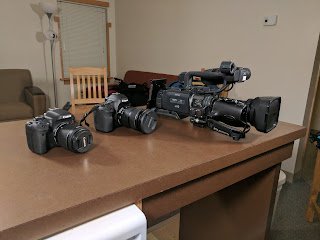Equipment Setup
 |
| The three cameras I use regularly. Canon T6i (left), Canon 5D Mark III (middle), JVC GY-HD100U (right). |
Firstly, my personal camera is a Canon EOS Rebel T6i, which is amazing to use for everyday video work. It has a touchscreen that I can use to change my focus, ISO, exposure, other lighting settings, and even lets me look at a histogram, which lets me see how well lit a subject is. The camera itself is decently lightweight and I use the lens that came with it, which is an EFS 18-55mm f/4-5.6 IS STM lens. The numbers refer to the focal length and the f/stop of the lens. This lens is decent, but it's just the basic one, so it's nothing spectacular. I wish it had some more zoom, but that's an issue to solve for another day. This is the camera that I use the most often and am the most familiar with. It's gotten to the point where I know it like the back of my hand and can use it wherever and whenever I need a camera.
 |
| The lighting setup I used to take the above pictures of the cameras. |
The last camera I use is the JVC GY-HD100U. This camera is a professional grade camcorder that belongs to the ONU TV station and if I'm being completely honest, is my absolute favorite out of the three to use. It's also the main camera I use when I shoot the performances at the Freed Center throughout the year. Even though it only shoots in 720p, compared to the other two, which shoot in 1080p. This is also the camera I know the absolute least about, so there is still a lot that I need to learn to really understand what is going on. I always love using the big professional equipment though. It gives me a taste of what is to come in the jobs that I'm going to be pursuing after college. The camera is made to be used in broadcasting for television, which is put out at 720p, so it makes sense that it only shoots in this resolution. Unlike the two DSLR cameras, you can get audio through an XLR input instead of a 3.5mm one without an adapter. This basically allows higher quality audio to be recorded and reduces the chance of there being interference due to how the cable is designed and connected. It also has physical controls for the audio and is more precise at managing it. The camera also records onto little magnetic tapes instead of an SD card, or other storage medium. This can make it an absolute pain to work with, because you have to rerecord the footage into a video editing software to be able to change anything in post production. I can't possibly hope to talk about this camera in its entirety in this post, so I might end up making another post at some point to really dive deep into it.
Finally, we have my lighting kit, which is a Dracast LED500 3-Light Kit. This is my own personal kit that I purchased over the summer and is what I used to take the picture with all three cameras. It is amazing to work with. Because it is an LED kit and not a tungsten kit, it won't get hot and doesn't use a lot of power at all. It's decently portable and is perfect for interviews or product shoots. My personal kit is the version that allows for replicating daylight (56 K), studio lights (32 K), and any color temperature in between. They can run off of both physical power cables plugged into outlets, or the same batteries that the JVC camera uses, which is incredibly useful. It makes setting the lights up a breeze. Lighting isn't something a lot of people think about when they think of a picture, or a video, but it's one of the most important, if not the most important, aspect of shooting photos and video. It's something that I wanted to take special care in making sure I got right, which is why I bought this kit.
This blog post was about the equipment I use to actually shoot the videos that I work on and is only half the story when it comes to making videos. The other half is my post-production setup, which I want to dedicate an entire blog post to, because of its importance in the videos I make.

Comments
Post a Comment